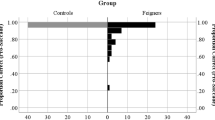Summary
Schizophrenic patients and patients with schizotypal personality disorder were significantly more likely than normal controls to demonstrate impaired eye tracking performance. Fifteen of 27 schizophrenics and 15 of 27 schizotypals had impaired eye tracking, compared with 11 of 39 normal controls. In the schizophrenic group, including 10 out-patients in a stable state of relative remission, impaired eye tracking was associated with more severe formal thought disorder and more time spent in psychiatric hospitals. Among stable schizophrenic out-patients, poor eye tracking was related to more severe formal thought disorder and greater overall psychopathology. This pattern of results suggests a possible relation between eye tracking impairment and more severe enduring symptoms across the spectrum of schizophrenic and schizophrenia-related disorders.
Similar content being viewed by others
References
American Psychiatric Association (1987) Diagnostic and statistical manual of mental disorders, 3rd edn (revised). Author, Washington, DC
Andreasen NC (1979) Thought, language and communication disorders: clinical assessment, definition of terms, and evaluation of their reliability. Arch Gen Psychiatry 36:1315–1321
Andreasen NC (1982) Negative symptoms in schizophrenia. Arch Gen Psychiatry 39:784–788
Andreasen NC (1984) The Scale for the Assessment of Positive Symptoms (SAPS). University of Iowa, Iowa City
Dworkin RH, Lenzenweger MF (1983) DSM-III and the genetics of schizophrenia. Am J Psychiatry 140:646
Dworkin RH, Lenzenweger MF (1984) Symptoms and the genetics of schizophrenia: implications for diagnosis. Am J Psychiatry 135:420–426
Endicott J, Spitzer RL (1978) A diagnostic review: the schedule for affective disorders and schizophrenia. Arch Gen Psychiatry 35:837–844
Holzman PS, Proctor LR, Hughes DW (1973) Eye-tracking patterns in schizophrenia. Science 31:143–151
Holzman PS, Proctor LR, Levy DL, Yasillo NJ, Meltzer HY, Hurt SW (1974) Eye-tracking dysfunctions and schizophrenic patients and their relatives. Arch Gen Psychiatry 31:143–151
Holzman PS, Kringlen E, Levy DL, Haberman S (1980) Deviant eye tracking in twins discordant for psychosis: A replication. Arch Gen Psychiatry 37:627–631
Holzman PS, Solomon CM, Levin S, Waternaux CS (1984) Pursuit eye movement dysfunctions in schizophrenia: Family evidence for specificity. Arch Gen Psychiatry 41:136–139
Holzman PS, Kringlen E, Matthysse S, Flanagan S, Lipton RB, Cramer G, Levin S, Lange K, Levy DL (1988) A single dominant gene can account for eye tracking dysfunctions and schizophrenia in offspring of discordant twins. Arch Gen Psychiatry 45:641–647
Iacono WG, Peloquin LJ, Lumry AE, Valentine RH, Tuason VB (1982) Eye tracking in patients with unipolar and bipolar affective disorders in remission. J Abnorm Psychol 91:35–44
Kuechenmeister CA, Linton PH, Mueller TV, White HB (1977) Eye tracking in relation to age, sex and illness. Arch Gen Psychiatry 34:578–579
Matthysse S, Holzman PS, Lange K (1986) The genetic transmission of schizophrenia: Application of Mendelian latent structure analysis to eye tracking dysfunctions in schizophrenia and affective disorder. J Psychiatr Res 20:57–67
Overall JE, Gorham DR (1962) The brief psychiatric rating scale. Psychol Rep 10:799–812
Rosen WG, Mohs RC, Johns CA, Small NS, Kendler KS, Horvath TB, Davis KL (1984) Positive and negative symptoms in schizophrenia. Psychiatry Res 13:277–284
Shagass C, Roemer RA, Amadeo M (1974) Eye-tracking performance in psychiatric patients. Biol Psychiatry 9:245–260
Siever LJ, Gunderson JG (1985) The search for a schizotypal personality: historical origins and current status. Compr Psychiatry 24:199–212
Siever LJ, Haier R, Coursey RD, Sostek A, Murphy DL, Holzman PS, Buchsbaum MS (1982) Smooth pursuit tracking impairment: Relation to other “markers” of schizophrenia and psychological correlates. Arch Gen Psychiatry 39:1001–1005
Siever LJ, Coursey RD, Alterman IS, Buchsbaum MS, Murphy DL (1984) Impaired smooth-pursuit eye movement: Vulnerability marker for schizotypal personality disorder in a normal volunteer population. Am J Psychiatry 141:1560–1566
Simons RF, Watkins W (1985) Smooth pursuit eye movements in subjects reporting physical anhedonia and perceptual aberrations. Psychiatry Res 14:275–289
Solomon CM, Holzman PS, Levin S, Gale HJ (1987) The association between eye-tracking dysfunctions and thought disorder in psychosis. Arch Gen Psychiatry 44:31–35
Spitzer RL, Endicott J, Robins E (1978) Research Diagnostic Criteria (RDC) for a selected group of functional disorders. 3rd edn. New York State Psychiatric Institute, Biometrics Research, New York
Stangl D, Pfohl B, Zimmerman M, Bowers W, Corenthal C (1985) A structured interview for the DSM-III personality disorders. Arch Gen Psychiatry 42:591–596
Strauss JS, Carpenter WT (1974) The prediction of outcome in schizophrenia, II: relationships between predictor and outcome variables. Arch Gen Psychiatry 31:37–42
Author information
Authors and Affiliations
Rights and permissions
About this article
Cite this article
Keefe, R.S.E., Siever, L.J., Mohs, R.C. et al. Eye tracking, schizophrenic symptoms, and schizotypal personality disorder. Eur Arch Psychiatr Neurol Sci 239, 39–42 (1989). https://doi.org/10.1007/BF01739742
Received:
Issue Date:
DOI: https://doi.org/10.1007/BF01739742




